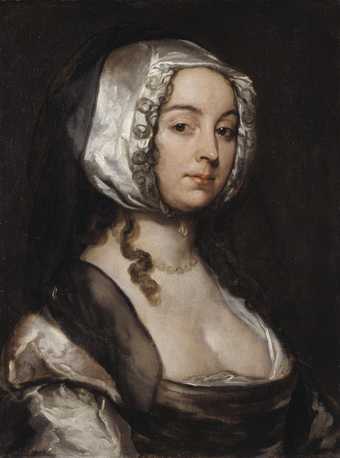
Fig.1
William Dobson 1611−1646
Portrait of the Artist’s Second Wife c.1635–40
Oil paint on canvas
624 x 470 mm
T06640
This painting is in oil paint on canvas measuring 624 x 470 mm (figs.1–2). The support is coarse, plain woven linen with 14 vertical and 12 horizontal threads per square centimetre; the threads are of uneven thickness with many slubs (fig.3). All the tacking margins are present. The cusping is sharply defined on the lower edge, slighter on the top edge and hardly exists on the uprights.1

Fig.2
Detail of the sitter’s head and chest
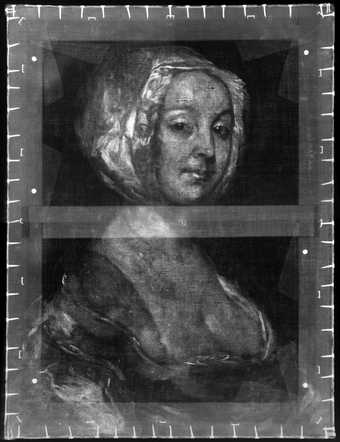
Fig.3
X-radiograph of Portrait of the Artist’s Second Wife
The ground is tan coloured, and was applied in two coats, composed of chalk with black and a range of earth pigments.2 There is a coat of unpigmented animal glue size between the two layers (fig.4).3 The dense network of very fine age cracks throughout the picture indicates that the ground is very brittle. The ground, although deeply embedded in the interstices of the canvas weave, just skims the top of the canvas-threads. It is present on the whole width of the tacking edges, although fragmented in many areas of them. The dark background colour is present across the whole width of the tacking margins on both uprights and the top edge, indicating that the image was originally larger, though from the amount of cusping on the top edge of the painting, probably not by much.
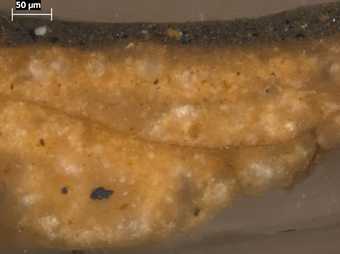
Fig.4
Cross-section through the dark background at the right edge, photographed at x320 magnification. From the bottom: tan coloured ground; thin coat of animal glue size; tan coloured ground; dark background paint
No underdrawing is apparent with the unaided eye or with infra-red reflectography. Examination through the stereomicroscope reveals dead-colouring beneath the recessive areas of the face and chest.4 The dead colouring is in greyish tones (almost black in the deepest areas of the face) and purplish mid-browns; it is opaque and was applied quite thickly as a rough lay-in of the shape of the sitter’s head and features (figs.5–6).
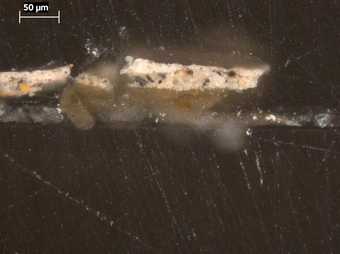
Fig.5
Cross-section through a shadowed area of flesh paint, photographed at x260 magnification. From the bottom: upper layer of tan coloured ground; opaque greyish dead colouring for the flesh tone; final flesh tone; varnish
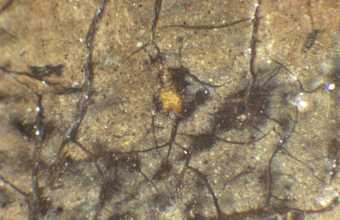
Fig.6
Detail at x8 magnification of a shadowed flesh tone, showing dark grey dead colouring beneath the final flesh tone
There are also pentimenti around the face, where the artist finally brought the front of the white linen cap over dark curls of hair, and in the left half of the chest, where the dark ringlets were originally to the left of the final position (figs.2, 7).
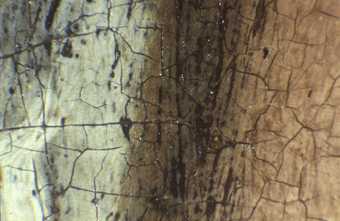
Fig.7
Detail at x8 magnification of the edge of the linen cap and the face, showing dark paint of a ringlet later painted over by the artist
Once the dead colouring had dried, the image was built up largely wet-in-wet with opaque paint-mixtures and vigorous brushwork. It was probably the work of one sitting with the exception of the changed position of the ringlets and the addition of the translucent black scarf. For the scarf a dark grey mixture was applied thinly on top of the flesh paint of her chest, the neckline of her dress and her white cap; all three areas appear to have been dry at this point. The pigments in the painting are mainly earth colours mixed with lead white, vermilion and charcoal black, of which there is much in the flesh tones, along with ultramarine blue to create the cool half-lights and the bluish whites of the eyes.
The painting had been cleaned and relined before acquisition by Tate. The canvas is reinforced with a stiff, modern lining of canvas with a paste adhesive, which appears to extend only to the turnover edges; the tacking margins are strip-lined with woven fibreglass and a modern synthetic adhesive, possibly Beva. The pine stretcher is contemporary with this lining. Although held in a fairly even plane now, the canvas has suffered creasing in the past, notably in a long diagonal line from her bodice to the lower left corner. Sometime in the fairly recent past the ground has suffered abrasion right down to the top of the canvas threads throughout the painting. The dark background colour appears slightly blanched in some areas. The varnish is a modern synthetic resin.
June 2003
